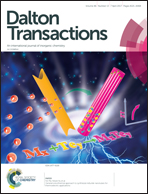Base assisted C–C coupling between carbonyl and polypyridyl ligands in a Ru-NADH-type carbonyl complex†
Abstract
A reaction of a ruthenium(II) NAD-type complex, [Ru(tpy)(pbn)(Cl)]+ (tpy = 2,2′:6′,2′′-terpyridine; pbn = 2-(pyridin-2-yl)benzo[b][1,5]naphthyridine), with pressurized CO (2 MPa) at 150 °C in H2O selectively produced a two-electron reduced ruthenium(II)-NADH-type carbonyl complex, [Ru(tpy)(pbnHH)(CO)]2+ (pbnHH = 2-(pyridin-2-yl)-5,10-dihydrobenzo[b][1,5]naphthyridine), rather than the oxidized [Ru(tpy)(pbn)(CO)]2+ complex. Indeed, [Ru(tpy)(pbnHH)(CO)]2+ was quantitatively oxidized to [Ru(tpy)(pbn)(CO)]2+ upon treatment with one equiv. of 2,3-dichloro-5,6-dicyano-p-benzoquinone (DDQ). The reactivity of [Ru(tpy)(pbnHH)(CO)]2+ with various bases was studied herein. Treatment of [Ru(tpy)(pbnHH)(CO)]2+ with a suitable organic base, 1,5-diazabicyclo[4.3.0]non-5-ene (DBN), resulted in the formation of a new five-membered Ru–CO-bridge metallacycle quantitatively in acetonitrile under air at room temperature. A probable mechanism was proposed for this reaction based on UV-vis, NMR, and EPR spectral studies and other experimental data. Furthermore, a reaction of the five membered Ru–CO-bridge metallacycle with NH4PF6 in CH3CN : H2O (1 : 1) under air smoothly produced another new six-membered Ru-OCO-bridge complex. A mechanism for the formation of a Ru-OCO-bridge complex was also proposed here on the basis of H2O18 experiments, DDQ treatment and other experimental data. These newly synthesized complexes appended with NAD-type ligands may have potential use as renewable hydride sources for organic reductions.



 Please wait while we load your content...
Please wait while we load your content...